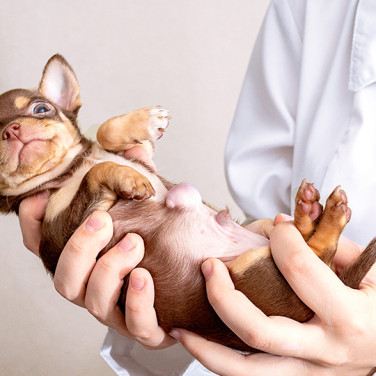DISEASES
Anal Sac Disease in Dogs - Causes, Symptoms, and Treatments | Buddydoc
페이지 정보
본문


What is anal sac disease in dogs?
Anal sac disease is a common issue in dogs, especially in overweight dogs and small breeds. The affected glands are located on both sides of the anus and are naturally drained when your dog passes a bowel movement, but sometimes the fluid in their anal sac glands becomes too thick to naturally drain and become impacted. This can lead to inflammation and swelling, causing pain when passing stools. The secretion within the sacs provides an ideal environment for bacterial growth as well, which can lead to infections such as anal sac abscesses. The abscess can cause painful swelling and, if left untreated, can damage the anus and rectum. Although, all breeds can be affected by anal sac disease, large or giant breeds of dogs are rarely affected.
Causes of anal sac disease in dogs
Anal gland issues in dogs can be caused by factors such as chronic skin dermatitis, obesity, insufficient dietary fiber, chronic soft stool, food and environmental allergies, and simply may just be down to genetics. The most common cause of anal sac disease is infection. When the anal sac becomes inflamed, it thickens and narrows the duct, so that secretions from the anal sac do not drain well and proceed to get clogged. Anal sac tumors may also cause associated diseases as well.
Certain breeds like German Shepherds and middle-aged male puppies who have not been neutered are more susceptible to anal sac diseases. While anal gland issues occur in dogs of any breed or size, small breeds tend to be more prone to them. It is also important to note, that once your dog experience anal sac impaction, it is much more likely to recur.
Symptoms of anal sac disease in dogs

The most common symptom of anal sac disease is typically indicated by scooting or dragging their rear end on the ground. You may also notice excessive licking or biting around the tail base, and a foul odor near the anus. Dogs may also experience difficulty passing stools or pain. If the anal sac ruptures, you may notice blood or pus coming out of the rectum. Behavioral changes in usually gentle dogs may become more irritable or aggressive if their tail or anus is touched due to the pain from anal sac disease.
Risk of anal sac disease in dogs
If left untreated, anal sac disease from infection can progress, resulting in increased pus discharge and bleeding, and an overall worsening of the pet’s condition. In severe cases, surgical removal of the anal sac may be necessary, but this can lead to damage to the surrounding nerves, potentially causing temporary fecal incontinence lasting 1 to 3 weeks, or even permanent damage. It is best to act early and resolve this condition before it progresses into anything more serious.
How to manage anal sac disease in dogs at home
To prevent further infection, it's important to keep your pet's anus area clean. If you notice any signs of blood or pus, it's crucial to seek treatment from a veterinary hospital as soon as possible. Adding fish oil or more fiber to your pet’s diet can help aid in preventing anal sac problems. Consult with your veterinarian on creating a diet plan that best suits your pet to help manage anal sac issues.
Diagnosing anal sac disease in dogs
Diagnosis of anal sac disease involves physical and visual examination and may require further tests such as microscopy, ultrasound, or biopsy. If an infection is suspected, the contents of the affected anal sac can be examined under a microscope to identify the type of bacteria and the extent of the infection. Impaction or abscessation can be confirmed through digital rectal examination and expression of the sacs, while a suspected tumor may require a biopsy for diagnosis. Additionally, an evaluation of metastasis for the suspected tumor and serum calcium measurement may be necessary.
Treatments for anal sac disease in dogs

Anal sac disease in dogs can be treated through various methods depending on its severity.
-
Warm compress
Compress with warm gauze to relieve pain.
-
Antibiotics and anti-inflammatory drugs
Antibiotics and anti-inflammatory drugs can be injected into the anal sac to treat infection and inflammation. Oral medications may also be used.
-
Immunosuppressants
If the suspected perianal fistula is immune-mediated, treatment with immunosuppressive drugs may be prescribed.
-
Surgery
Anal sac disease may require surgical intervention to remove the dog’s anal sac. Additionally, if the anal sac disease is caused by a tumor, surgical removal of the tumor will also be considered.
-
Cryotherapy
Cryotherapy can freeze the affected area which can reduce infection and assist in the healing process.
Reassessment and repeat treatment may be necessary as anal sac diseases typically recur. Contact your vet whenever you suspect anal sac disease in your dog.
Preventing anal sac disease in dogs
To prevent anal gland problems, discuss a diet plan with your veterinarian that includes fish oil and an increased intake of dietary fiber. Canned pumpkin and unsalted pumpkin seeds can also help. To prevent anal sac disease, keep your dog at a healthy weight with exercise, and have their anal sacs checked regularly by a vet, especially if they are small and obese.
Find out more about your dog’s symptoms and diseases on the Buddydoc app!

The Buddydoc library is filled with everything you’d want to know about each symptom and disease your pet may experience. If you would like to find out more about the causes, signs, treatments, preventions, and more for your dog’s disease. Try out the Buddydoc app and search for your pet’s symptoms or diseases in the Buddydoc library.













